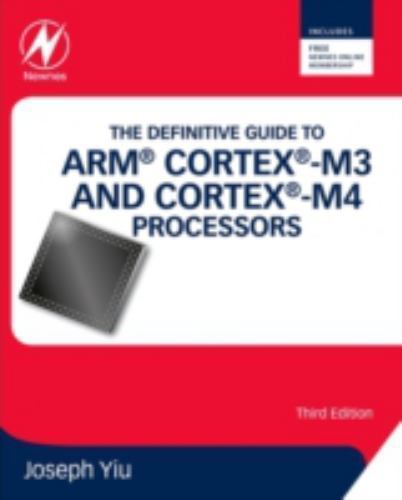Picture 1 of 1

Stock photo

Picture 1 of 1

Stock photo

Definitive Guide to ARM® Cortex®-M3 and Cortex®-M4 Processors by Joseph Yiu (2013, Trade Paperback)

Awesomebooksusa (438973)
98% positive feedback
Price:
US $20.32
ApproximatelyRM 86.22
+ $6.99 shipping
Returns:
30 days return. Buyer pays for return shipping. If you use an eBay shipping label, it will be deducted from your refund amount.
Condition:
Oops! Looks like we're having trouble connecting to our server.
Refresh your browser window to try again.
About this product
Product Identifiers
PublisherElsevier Science & Technology
ISBN-100124080820
ISBN-139780124080829
eBay Product ID (ePID)150580089
Product Key Features
Number of Pages864 Pages
Publication NameDefinitive Guide to Arm® Cortex®-M3 and Cortex®-M4 Processors
LanguageEnglish
SubjectMicroprocessors, Electronics / Microelectronics
Publication Year2013
TypeTextbook
Subject AreaComputers, Technology & Engineering
AuthorJoseph Yiu
FormatTrade Paperback
Dimensions
Item Length9.2 in
Item Width7.5 in
Additional Product Features
Edition Number3
Intended AudienceScholarly & Professional
LCCN2014-415768
Dewey Edition23
TitleLeadingThe
IllustratedYes
Dewey Decimal621.3916
Table Of Content1. Introduction2. Embedded Software Development3. Technical Overview4. Architecture5. Instruction Set6. Memory system7. Exceptions and Interrupts8. Exception handling in details9. Low power and System Control Features10. OS support features11. Memory Protection Unit12. Fault Exceptions13. Floating point14. Debug features introduction15. Getting Started with Keil MDK-ARM16. Getting Started with IAR Embedded Workbench17. Getting Started with GNU C Compiler18. Software examples19. Using embedded OS20. Assembly programming and mixed language projects21. Cortex-M4 DSP Instructions (Paul Beckmann, DSPConcepts)22. CMSIS DSP Library (Paul Beckmann, DSPConcepts)23. Advanced topics24. Software porting Appendix A. ISA summaryB. DSP instructions graphical representationC. 16-bit Thumb instruction changes since v4TD. Exceptions Quick ReferenceE. CMSIS-Core functions Quick ReferenceF. NVIC and SCB registers quick referenceG. Debug Registers quick referenceH. Debug and Trace connectorI. Trouble shooting guide
SynopsisThis new edition has been fully revised and updated to include extensive information on the ARM Cortex-M4 processor, providing a complete up-to-date guide to both Cortex-M3 and Cortex-M4 processors, and which enables migration from various processor architectures to the exciting world of the Cortex-M3 and M4. This book presents the background of the ARM architecture and outlines the features of the processors such as the instruction set, interrupt-handling and also demonstrates how to program and utilize the advanced features available such as the Memory Protection Unit (MPU). Chapters on getting started with IAR, Keil, gcc and CooCox CoIDE tools help beginners develop program codes. Coverage also includes the important areas of software development such as using the low power features, handling information input/output, mixed language projects with assembly and C, and other advanced topics. Two new chapters on DSP features and CMSIS-DSP software libraries, covering DSP fundamentals and how to write DSP software for the Cortex-M4 processor, including examples of using the CMSIS-DSP library, as well as useful information about the DSP capability of the Cortex-M4 processor A new chapter on the Cortex-M4 floating point unit and how to use it A new chapter on using embedded OS (based on CMSIS-RTOS), as well as details of processor features to support OS operations Various debugging techniques as well as a troubleshooting guide in the appendix Topics on software porting from other architectures A full range of easy-to-understand examples, diagrams and quick reference appendices, This new edition has been fully revised and updated to include extensive information on the ARM Cortex-M4 processor, providing a complete up-to-date guide to both Cortex-M3 and Cortex-M4 processors, and which enables migration from various processor architectures to the exciting world of the Cortex-M3 and M4. This book presents the background of the ARM architecture and outlines the features of the processors such as the instruction set, interrupt-handling and also demonstrates how to program and utilize the advanced features available such as the Memory Protection Unit (MPU). Chapters on getting started with IAR, Keil, gcc and CooCox CoIDE tools help beginners develop program codes. Coverage also includes the important areas of software development such as using the low power features, handling information input/output, mixed language projects with assembly and C, and other advanced topics.
LC Classification NumberTK7895.E42
Be the first to write a review





